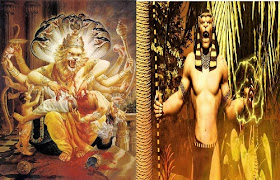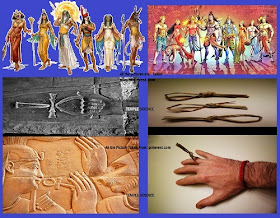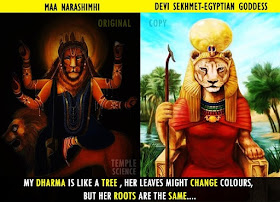Thousands of years ago the world was not divided by today's present territories.Distinctions of beliefs, culture and scriptures were of no conflict. During the half part of the World Cycle, we slowly started descending in soul consciousness away from the Supreme Light of the one Truth and entered the age of Dwarpara Yuga.As part of the cycle we eventually began to forget that we were Divine souls and became body conscious.There slowly rose anarchy all over the world, creating division of all things.This was an extremely unstable period, which eventually led into the age of darkness known as Kali Yuga. This iron age began to influence the minds of many.
The world continued dividing into multiple parts and the original Vedic culture was altered by those led by such a dark period. This is why there seems to be a "copying" of Vedic culture among the many different religions and scriptures. In this article I would like to show a underlying memorial within the Egyptian culture; with focus on the Ankh symbol.
German Indologist Peter Von Bohlen (1796-1840) likened India to ancient Egypt. He believed in ancient times there was a cultural link between the two. In his book, Empire of the Soul: Some Journeys in India, Page 300, Paul William Roberts, wrote:
"Recent research and scholarship make it increasingly possible to believe that the Vedic era was the lost civilization whose legacy the Egyptians and the Indians inherited. There must have been one. There are too many similarities between hieroglyphic texts and Vedic ones, these in turn echoed in somewhat diluted form and a confused fashion by the authors of Babylonian texts and the Old Testament."
In Egypt it was not looked at as a physical reproduction. Pictography was used among the hieroglyphics, which literally meant something and then symbolically spiritually meant something else. The Ankh was used as a key to immortal life of transcendence, into the higher realms of existence through purification of combined energies. As a whole the Egyptians looked forward to the after life and simply witnessed the present life as a mere speck of space in time. This is why such a symbol is seen everywhere and emphasized throughout their culture. A constant repetitiveness among the hieroglyphics, some slaves wore them made of wood, used in ceremonies, the Kings and royal court wore them in solid gold around their necks and entire palaces would be decorated with the Ankh. It even would be used in their names. For example the most famous known Pharaoh in history is King Tutankhamun (King Tut). King Tutankhamun is actually falsely pronounced. The correct pronunciation would be separated and read as King Tut-Ankh-Amun. Ankh being his middle name. And his full name actually meant Eternal-Life-Om (amun) Understood in the proper pronunciation a correlation between Vedic culture can be seen. The Ankh by Egyptologist is called the "symbol of life."
Representing the male and female unit under a pure Divine form as a trinity.There are even Egyptian sculptures where the suns rays are represented as terminating in hands, in a offering of purification towards the Ankh, a emblem of the Truth that a fruitful union of the triad is a gift from a Supreme Being. From a certain shift of perspective the Ankh (even in form) can be seen as the Pavithram of Hindus.
As known, the Pavithram ring (or key) is made out of Holy Darbha grass and worn on the right finger (wearing the ring on the right finger and hand is said to activate the Pingala nadi) during the performance of Vedic ceremonies. The word Pavithram in Sanskrit means purity. Hence the ring substitute of grass bearing that name implied that the man performing the rites and ceremonies becomes purified by wearing it (physically,emotionally and mentally). Like the Egyptians received subtle energy with their use of the Ankh, the wearer of the Pavithram also receives a certain energy. The Ankh and Pavithram both aided in helping maintaining a certain balance within and activating dormant energies.Now lets take a closer look at the importance of these activated energies that were realized and used in such a way in both cultures. What is really being spoken of?
According to the scientific application of Yoga there are three major subtle passages (nadis) of vital life force energy which are connected through countless passages in our physical bodies.The even consistent flow through these passages aids in the balanced function of our bodies system.There are three major passages of energy called Ida, Pingala and Sushumna nadis. On the left side of the spinal chord is Ida (female) and Pingala (male) represented on the right. Again, this is not a literal reference to actually being male or female, but is in reference to certain qualities in nature itself. Now the Sushumna passage lies in the spinal chord itself, and this is through which the Kundalini energy flows when Ida and Pingala are brought to a balance. Through spiritual cultivation this powerful cosmic energy is aroused.
Until activation through application of Yoga this powerful energy lies at the lower end of the Sushumna channel dormant within the space of the Mooladhara chakra. This energy penetrates, entering the Sushumna nadi and flows upward through the six chakras along the spinal chord and unites with Divine consciousness located at the base of the brain stem known as the Medulla oblongata.When this union happens, the individual consciousness becomes one with the Supreme consciousness. The Ida and Pingala combined (Kundalini) energy in itself is the subtle energy of human evolution. Although used differently one cannot fully dismiss the similarities. Both Pavithram and Ankh exerted a subtle influence in activating the Divine energies within the body.
All other religious cultures have been proven to be dated. When translated to English, Sanatana refers to Eternal, Universal, Ever-present, Never beginning nor ending and Dharma refers to Truth,The way, Harmony, Cosmic norm. Sanatana is a Sanskrit word that denotes that which is Anadi (beginningless), Anantha (endless) that which is everlasting and eternal and never ceases to be. Dharma is from dhri, meaning to sustain, hold together. The principles of reality which are inherent in the core and design of the universe itself. Thus Sanatana Dharma can be roughly translated to..the natural ancient and eternal way.
With this being said, seeing it from this point one could understand that any scriptures, teachings or rituals that remotely resemble Vedic culture is simply a memorial of the the original Truth.
 |
| Facial similarities between Indian God Varaha Avatar (3rd incarnation of lord Vishnu)and the Egyptian God Anubis (right side) |
 |
| Peter Von Bohlen (1796-1840) |
"Recent research and scholarship make it increasingly possible to believe that the Vedic era was the lost civilization whose legacy the Egyptians and the Indians inherited. There must have been one. There are too many similarities between hieroglyphic texts and Vedic ones, these in turn echoed in somewhat diluted form and a confused fashion by the authors of Babylonian texts and the Old Testament."
Lets start by correcting the myth that the Ankh is a symbol of ultimate death. It was actually seen by the Egyptians as a symbol of hope and life eternal. The upper round part represented the female womb (energy) and the horizontal part represented the male organ (energy). Through the male and female energies the eternal life physically exist and happens through the reproductive system process, but this was simply symbolism.
It went beyond that. |
| Facial similarities between Indian God Narshima Avatars (4th incarnation of Lord Vishnu) and Egyptian God Maahes |
Representing the male and female unit under a pure Divine form as a trinity.There are even Egyptian sculptures where the suns rays are represented as terminating in hands, in a offering of purification towards the Ankh, a emblem of the Truth that a fruitful union of the triad is a gift from a Supreme Being. From a certain shift of perspective the Ankh (even in form) can be seen as the Pavithram of Hindus.
 | |||||||
The picture shows the goddess Hathor holding the Ankh
up under the nose of Nefertari. Image Credit: pinterest.com
|
According to the scientific application of Yoga there are three major subtle passages (nadis) of vital life force energy which are connected through countless passages in our physical bodies.The even consistent flow through these passages aids in the balanced function of our bodies system.There are three major passages of energy called Ida, Pingala and Sushumna nadis. On the left side of the spinal chord is Ida (female) and Pingala (male) represented on the right. Again, this is not a literal reference to actually being male or female, but is in reference to certain qualities in nature itself. Now the Sushumna passage lies in the spinal chord itself, and this is through which the Kundalini energy flows when Ida and Pingala are brought to a balance. Through spiritual cultivation this powerful cosmic energy is aroused.
Until activation through application of Yoga this powerful energy lies at the lower end of the Sushumna channel dormant within the space of the Mooladhara chakra. This energy penetrates, entering the Sushumna nadi and flows upward through the six chakras along the spinal chord and unites with Divine consciousness located at the base of the brain stem known as the Medulla oblongata.When this union happens, the individual consciousness becomes one with the Supreme consciousness. The Ida and Pingala combined (Kundalini) energy in itself is the subtle energy of human evolution. Although used differently one cannot fully dismiss the similarities. Both Pavithram and Ankh exerted a subtle influence in activating the Divine energies within the body.
 |
| Ankh for both Egyptian spirituality and Indian spirituality. |
With this being said, seeing it from this point one could understand that any scriptures, teachings or rituals that remotely resemble Vedic culture is simply a memorial of the the original Truth.
Spirituality was a crucial part of the lives of ancient Egyptians along with many other civilizations, and they worshiped several gods and goddesses.
There were over 2000 deities, most of whom were able to take the form of animals.
Depending on the time frame, region, and temple, the same animal may represent a unique deity. The most famous ancient Egyptian goddesses are Ra, Osiris, Isis, Anubis, Horus, Sobek, Seth, Thoth, Bastet and Kheper.
 |
| The Article is written by Jillian Renee Riley. |
Note:The Article was first published in our Facebook page Temple Science on 9 April 2018. Some websites deliberately copied our article from our Page and published on their timeline.
An interesting news of India Today claims, that the great grand father of King Tutankhamen was from south India.Do you think waves of ancient vedic migrations to the West resulted in the development of the great civilizations of Egypt and Mesopotamia....??
Share your opinion..


Good information, important to know too. Thank you for sharing.
ReplyDeleteSo kind of you. Keep reading we will come with more facts.
DeleteThere was a book written called connecting the dots or something about this, would love to read it!
ReplyDeletesure :)
Delete